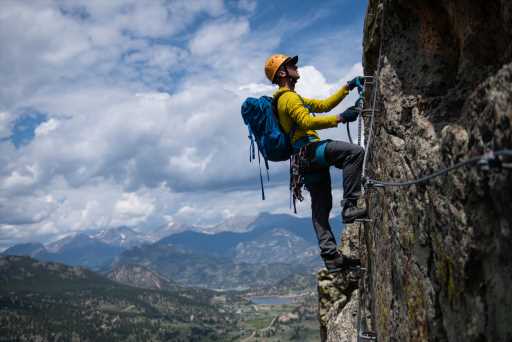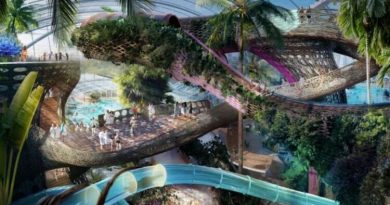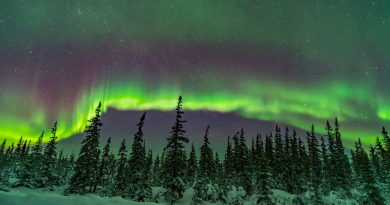Estes Park via ferrata: Cloud Ladder is steepest in U.S.
Midway up the new Cloud Ladder via ferrata climbing route just outside of Estes Park, touted as the steepest in the U.S., there is an overhanging 30-foot section that represents the crux of the ascent. It’s not a severe overhang, just a few degrees beyond vertical, tilting just enough so climbers have to lean away from the rock face, trust the protection system and pull themselves up the overhang primarily with their arms.
The face tilts toward the climber just enough to make it a little scary, especially with 300 feet or so of exposure below. “Exposure” is a mountaineering term meaning, “If you fall, it’s a long way down.”
Climbers on the route wear harnesses and are protected at all times via half-inch steel cables anchored to the rock face, and all are accompanied by experienced mountain guides. So the Cloud Ladder was just scary enough to be fun for seven Wisconsin YMCA camp teenagers who made the 600-foot ascent to the summit this week to conclude a 10-day Colorado adventure trip.
Alex Wittig, 16, conceded she was “super nervous” when she started up the overhang. “But afterward it was like, ‘Oh, yeah, I just did that,’” Wittig said. “You’re like, ‘Wow. I did it.’”
Via ferrata means “iron way” in Italian. The original via ferrata was built in Italy’s Dolomite mountains during World War I to help Italian soldiers repel invasion from the north. Since then, via ferratas in Europe have been converted for recreational use, and about 20 have been built for adventure in the U.S. They include one in Telluride, completed more than a decade ago that is a mostly horizontal traverse with hundreds of feet of exposure, and a new one at Arapahoe Basin that opened this summer.
The new Cloud Ladder route was built adjacent to an easier route called Peregrine Ridge that opened in 2017, and together they are called the Alpine Jewel. Both were built by Harry Kent and Keith Lober, longtime climbing partners whose list of accomplishments includes becoming the first Americans to make a winter ascent of the notorious 6,000-foot north face of the Eiger in Switzerland. They also climbed together in Yosemite, the Andes and the Himalayas.
RELATED: Arapahoe Basin via ferrata, highest in North America, tops out at 13,000 feet
For most of the Cloud Ladder route, there are U-shaped pieces of rebar anchored in the rock that function as steps and hand holds. In a few places, Kent and Lober have let climbers utilize natural rock features for their hand and foot holds instead of artificial steps so they can feel more like real rock climbers.
“We had to decide how many of those we were going to use,” said Kent, who has lived in Estes Park since 1974. “It’s a very delicate decision on how much you make somebody work for it and how much you say, ‘Let them keep climbing and enjoy it.’ We chose, ‘Let them enjoy it, let them get to a place they could never get to unless they were a climber,’ and I think we did pretty good with that. Sometimes I go, ‘You know, I think we did make it too easy.’ But with the overhang, the bottom line is that it is an adventure.”
It certainly was for the kids from Wisconsin.
“There were a lot of mental blocks by looking up, like, ‘I can’t do this,’ but I am so happy to be around so many people who were willing to cheer me on and encourage me during it,” said Carly Rechtorik, 17. “Even when I was really, really scared and screaming, they were pushing me through it, and it felt really rewarding.”
Lee Jones, 16, said he loved the climb.
“I’ve climbed a little bit in Milwaukee and Wisconsin, but this is like the real thing,” Jones said. “It’s sort of freaky looking down, but I just decided, ‘I’m just going to go for it, I want to get to the top.””
Owen Killoran, 16, felt his clip jiggle slightly on the cable while he was leaning away from the face, and while he was in no danger, there was a jolt of fear.
“I really did think I was going to die,” Killoran said, making light of his momentary fright. “But I felt so safe with the guides, so it was kind of a funny thing, with a little bit of scariness but overall a lot of accomplishment.”
For a sense of scale, downtown Denver’s tallest buildings are just over 700 feet in height. The Cloud Ladder route has a vertical rise of a little more than 600 feet, while the Peregrine Ridge route rises about 400 feet. Guided trips are run through the Kent Mountain Adventure Center, which Kent created three decades ago.
There are some gorgeous views on the Alpine Jewel routes, including a view to the north of Estes Park, four miles away and 1,700 feet lower in elevation. Next year there will be a new way to make the most of the panorama. The Alpine Jewel will have places to spend the night up on those crags with ledges attached to the rock face that they are are calling Cloud Decks. They will be 12 feet by 12 feet, with glass walls and a canopy overhead. Campers would access the Cloud Decks by climbing the via ferrata.
Another new feature will be added this summer: A pair of 40-foot cable bridges crossing a ravine with 300 feet of exposure.
Without the via ferrata hardware, it would be an all-day proposition to climb the Alpine Jewel routes using normal rock-climbing equipment with a guide. It’s much quicker — and a lot less intimidating — with the iron hardware in place.
“The beauty of the via ferrata is that it gets you to an awesome position, relatively easily and relatively quickly,” Kent said. “We’ve had people up there who would have no reason to hire a guide to go rock climbing, but they have reason to hire a guide to do something that’s easier than rock climbing, that isn’t as technical, that you don’t have to get freaked out about. We’ve opened up recreation for a whole new culture.”
Subscribe to our weekly newsletter, The Adventurist, to get outdoors news sent straight to your inbox.
Source: Read Full Article





